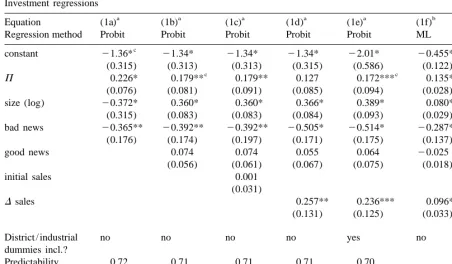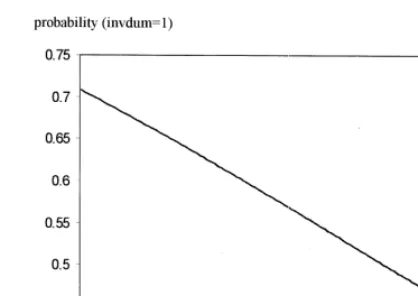www.elsevier.com / locate / econbase
q
Is the bad news principle for real?
*
Jakob Svensson
Development Research Group, DECRG-MG, The World Bank, 1818 H Street NW, Washington DC 20433, USA Received 5 April 1999; accepted 19 July 1999
Abstract
The bad news principle states that only the expected severity of future bad news matters for the decision whether to invest today, good news should not matter at all. This paper tests this prediction using firm level expectation data. 2000 Elsevier Science S.A. All rights reserved.
Keywords: Bad news principle; Investment; Uncertainty
JEL classification: D92
1. Introduction
Is the bad news principle for real? The bad news principle states that only the expected severity of future bad news matters for the decision whether to invest today. Potential good news should not matter at all. The intuitive reason for this asymmetry is that the option to wait has no value in states in which investing would have been the correct decision. In fact, the option to wait is only valuable in states in which the investment would have been regretted. This paper tries to assess the importance of this result by exploiting an unique data set from a recently implemented firm survey in Uganda. Variables representing the expected severity of bad and good outcomes are constructed using a subjective probability distribution of future demand, as reported by the firm managers. The results indicate that expectations of bad outcomes reduce both the probability that the firm will invest and the level of investment, while expectations of good outcomes have no significant effect. Thus, the bad
1
news principle seems to be for real!
q
Not for citation without permission from the author. Views expressed here do not represent official opinions of the World Bank.
*Tel.:11-202-473-9109; fax: 11-202-522-3518.
E-mail address: [email protected] (J. Svensson)
1
For an excellent short review of the literature on irreversible investment and uncertainty, as well as empirical evidence on the relationship between investment and uncertainty / instability, see Serven (1997). For a comprehensive text book treatment on investment under uncertainty, see Dixit and Pindyck (1994).
2. A conceptual framework
Consider a risk-neutral firm that has to decide whether to make a capital investment i.0. The unit cost of capital is normalized to unity. Investment is irreversible. To keep things simple, there are no operating costs and the investment is instantaneously productive, yielding a known profit p05p.
h
Future profit is uncertain. Specifically, pt, for all t.0, can take two values: high profit (pt 5gp)
l
which occurs with probability q, or low profit (pt5bp) which occurs with probability 12q, where g.1.b. We postulate that p.ri.bp; that is, the return in the bad state is lower than the user cost of capital (ri ), and that in the absence of uncertainty, the firm would choose to invest. Note, that we assume that the uncertainty vanishes after one period. Although extreme, this assumption gives the firm incentive to wait with the investment until more information is available.
Will the firm invest? If a firm invests today, the net present value of the investment is simply,
`
2t
V05 2i1p1
O
(11r) E0f gpt (2.1)t51
Even if V0.0, the firm may still not invest. It might be profitable to wait. The NPV of waiting (one period) and investing if future profits are high is,
`
where c;ri is the user cost of capital. This condition is intuitive. If capital was fully reversible, the firm’s investment rule is simply to invest if the current return (p) exceeds the user cost of capital (c). With uncertainty and irreversible investment, the firm will wait undertaking the project until current profit exceeds the user cost of capital by the multiple rf 1(12q) / rg f 1(12q)bg.1. Note that the magnitude of the ‘bad news’, (12q)b, raises the incentive to wait.
An interesting characteristic of (2.3) is that only bad news matters. The probability and magnitude of expected good outcomes are irrelevant for the investment decision. This is the bad news principle first noted by Bernanke (1983): only the expected severity of future bad news matters for the decision whether to invest today, potential good news does not matter at all.
2.1. Empirical specification
*
*
Eq. (2.3) provides the basis for the empirical specification.p is unobserved, so we treat p as a latent variable, correlated with c, b, and r, where b;(12q)b is the severity of the bad news. Let invdum 51[0] be the event that a firm [do not] invests in machinery, plant and / or equipment in
i
1997. We can then rewrite (2.3) as a probit model,
Pr ins vdum 51d5F(p, c , b , r) (2.4)
i i i i
World Bank survey in Uganda on firms’ investment responses to structural reforms [see Reinikka and Svensson (1998)], in which information on the owners’ (managers’) expectations of future demand is
2,3
available. Profit (p) is measured as gross sales less total operating costs and interest payments. The variable c is not directly observable. As a rough proxy we use size of the firm. The presumption is that larger firms are more likely to have access to lower cost capital (external finance).
In the survey, firm managers were asked about their expectations of future demand (one-year ahead). The owners stated the likelihood of different events, with the probabilities summing up to 100. We will use the end points of this discrete probability distribution to calculate the severity of the bad news. The news measures are defined as:
bad news5Pr[reduction in sales by more than 20%]30.83S0
good news5Pr[increase in sales by more than 20%]31.23S0
where S is initial sales. Note that the news measures are conditional on initial sales. Thus, we allow0 4
the responses to news about demand to differ with respect to the firms’ initial positions.
3. Results
The results are reported in Table 1. The basic regression is depicted in column (1a). All variables enter significantly. Importantly, the bad news proxy is highly negatively correlated with the probability that the firm invests. The interesting feature of the bad news principle however is not only that bad news matters, but the asymmetry between good and bad news. The incentive to wait is a function of bad news only. In column (1b) we add the proxy for good news. As evident, the bad news proxy continues to be highly negatively correlated with the probability that the firm invests, while the good news proxy enters insignificantly and with a coefficient close to zero. Thus, the expected severity of future bad news matters for the decision whether to invest, potential good news does not. To test that the results for the news variables are not driven by cross-sectional variation in initial sales, we add S to the base specification [column (1c)]. Once controlling for size, profit and the news0 variables, initial sales provides no new information, neither does it affect the relationship between bad news, and the probability of investment.
In column (1d) we add an additional control: change in sales (Dsales). A flexible accelerator model would predict that investment is driven by demand changes [see e.g. Tybot (1983)]. As evident,
Dsales does pick up some variation in the dependent variable. However, adding this variable does not affect the results with respect to bad news, good news and the probability of investment.
The results are neither driven by sector and regional specific differences. In fact, including regional
2
The idea for the survey question comes originally from Guiso et al. (1992) who use subjective expectations data to create measures of mean earnings growth and variance to test for precautionary savings by households. Pattillo (1997) creates similar measures to study the relationship between investment and uncertainty in a cross-section of firms.
3
As described in detail in Reinikka and Svensson (1999), the sample consisted of 243 firms. We have data for all relevant variables for 192 firms. An initial inspection of the data led us to disregard nine observations due to erroneous recording of data and / or misreporting, leaving a sample of 183 firms.
4
Table 1
Investment regressions
a a a a a b b
Equation (1a) (1b) (1c) (1d) (1e) (1f) (1g)
Regression method Probit Probit Probit Probit Probit ML ML
c
constant 21.36* 21.34* 21.34* 21.34* 22.01* 20.455* 20.706* (0.315) (0.313) (0.313) (0.315) (0.586) (0.122) (0.225)
c c
P 0.226* 0.179** 0.179** 0.127 0.172*** 0.135* 0.127*
(0.076) (0.081) (0.091) (0.085) (0.094) (0.028) (0.028)
size (log) 20.372* 0.360* 0.360* 0.366* 0.389* 0.080* 0.090*
(0.315) (0.083) (0.083) (0.084) (0.093) (0.029) (0.031) bad news 20.365** 20.392** 20.392** 20.505* 20.514* 20.287** 20.262* (0.176) (0.174) (0.197) (0.171) (0.175) (0.137) (0.136)
good news 0.074 0.074 0.055 0.064 20.025 20.024
(0.056) (0.061) (0.067) (0.075) (0.018) (0.019)
initial sales 0.001
(0.031)
Dsales 0.257** 0.236*** 0.096* 0.103*
(0.131) (0.125) (0.033) (0.034)
District / industrial no no no no yes no yes
dummies incl.?
Predictability 0.72 0.71 0.71 0.71 0.70
R2 0.22 0.24
No. invdum51 97 97 97 97 97
Observations 183 183 183 183 183 183 183
a
Dependent variable invdum takes the value 1 if the firm invested in machinery, plant or equipment in 1997 and 0 otherwise, standard errors in parenthesis corrected for heteroscedasticity.
b
Dependent variable is investment in machinery, plant and equipment in 1997 as share of previous period’s capital stock, standard errors in parentheses.
c
* [**] (***) denotes significance at the 1 [5] (10) percent level.
and sector specific dummies has no impact at all on the relationship between news and the probability of investment [column (1e)].
The effect of bad news on the probability of investing is fairly large. Fig. 1 plots the relationship between the expected probability of a major reduction in sales (more than 20 percent) and the probability of investing.
Columns (1f)–(1g) display the results of estimating the model in levels instead, accounting for the fact that roughly half of the firms did not invest during the period. That is, we estimate a tobit regression with investment in machinery, plant and equipment in 1997, as share of previous period’s capital stock as dependent variable. As evident, the results continue to hold with this alternative specification. Bad news reduces investment, while good news has no significant effect. These results are again robust to sector and regional specific effects [column (1g)].
4. Conclusion
Fig. 1. Probability of investing.
would have been the correct decision anyway, good news should not matter at all. This paper tried to assess the importance of the bad news principle using data from industrial firms in Uganda. Variables representing the expected severity of bad and good outcomes were constructed using a subjective probability distribution of future demand, as reported by the owners. The results indicated that expectations of bad outcomes reduced both the probability that the firm would invest and the level of investment, while expectations of good outcomes had no significant impact on the firm’s investment decision. Thus, the bad news principle seems to be for real!
Acknowledgements
I am grateful for comments by Ritva Reinikka and Aart Kraay. Correspondence to: Jakob Svensson, Development Research Group, The World Bank, 1818 H Street NW, Washington D.C. 20433, USA.
References
Bernanke, B.S., 1983. Irreversibility, uncertainty, and cyclical investment. Quarterly Journal of Economics 98, 85–106. Dixit, A., Pindyck, R.S., 1994. Investment Under Uncertainty, Princeton University Press, Princeton, NJ.
Guiso, L., Japelli, T., Terlizzese, D., 1992. Earnings uncertainty and precautionary saving. Journal of Monetary Economics 30, 307–337.
Pattillo, C., 1997. Investment, uncertainty and irreversibility in Ghana. mimeo, Oxford University.
Reinikka, R., Svensson, J., 1999. Confronting competition: firms’ investment response and constraints in Uganda. In: Collier, P., Reinikka, R. (Eds.), Assessing an African Success: Farms, Firms, and Government in Uganda’s Recovery, (forthcoming), World Bank.
Serven, L., 1997. Uncertainty, instability and irreversible investment. Policy Research Working Paper No. 1722, The World Bank.

